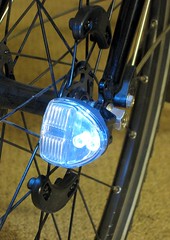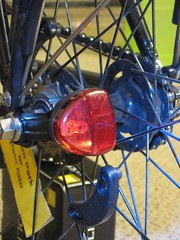The Danish Reelight has gotten quite a bit of attention over the past year ever since they introduced their unique, battery-less bike lights. The iFlasher light was nominated for an award in the Danish INDEX Design Competition.
Hiawatha Cyclery in Minneapolis has had the Reelight bike lights available in the U.S. for a while now, but the SL100 and SL120 lights from Reelight are now becoming more widely available in the USA. Dealers this year were signing up left and right for the lights this year at Interbike, and I know that my local bike shops began receiving their shipments of these lights this week.
I evaluated the SL100, which is the basic model with front white light, rear red light, brackets and two magnets for each light. The lamps are mounted on the wheel axles; the magnets are mounted to the spokes. As the wheel spins, the magnets pass near the lights generating a small electric current which momentarily illuminates the two LEDs in each light. The result is an LED “blinky” bike light with no batteries. Here are the lights as seen on my commuter bike.


Installation is fairly straightforward, though some dexterity is required to mount the spoke magnets. Wheels with disc brakes may require a version of the light with longer brackets. One bike mechanic I spoke with expressed some concern about installing these lights on a wheel equipped with quick release skewers — he thought there was a chance the magnets can catch the quick release and open it on the fly. The Reelight sales rep I spoke with, however, told me that QR mounting is common and he’s not aware of any problems or mishaps arising from installing the Reelight lights on QR wheels. The only problem has been with mounting the lights on some front suspension forks with recessed hub bolts, according to Reelight.
The lights are reasonably bright and flash twice on each wheel revolution. One common concern is the low mounting location of these lights. According to Reelight, though, “Lights mounted at the hub are not a new thing.” Particularly when riding next to heavy traffic on a dark morning I can see an advantage of a low-mounted light: they are always in a dark place and appear more visible. Handle bar mounted lights have a tendency to get lost in the “noise” of car headlights and street lighting, while lights that are low to the ground don’t compete with those other light sources.
If you ride with rear panniers, your rear light may be partially covered as they are on my bike as pictured here. If you don’t ride with panniers or if they don’t extend all the way to the hub, you should be fine. For those with panniers, Reelight plans other mounting options in the future that may help you out.

I really like the Reelight bike lights and I don’t hesitate at all in recommending them. The SL100 is the basic light as pictured here. The SL120 is almost identical except it has a standlight feature — a little bit of charge is saved during operation so that the lights continue flashing even when you’re stopped. I need to emphasize that these are strictly “be seen” lights — if you ride away from street lighting, you’ll need a more powerful headlight to illuminate your path. For city riding, though, these flashing LEDs are a low maintenance way to make you a little more visible.
While U.S. dealers are now receiving the lights from their distributor, I’ve heard there might be problems with product displays. If you want this light, you might need to ask for them at the shop. The basic SL100 with two lights is about $50 at U.S. bike shops; the SL120 two light kit with the standlight is about $60. The lights are distributed in the USA by J&B Imports.
Note: CBB previously reported that the SL100 retails for $40 and the SL120 retails for $50. We regret the error.